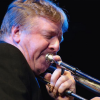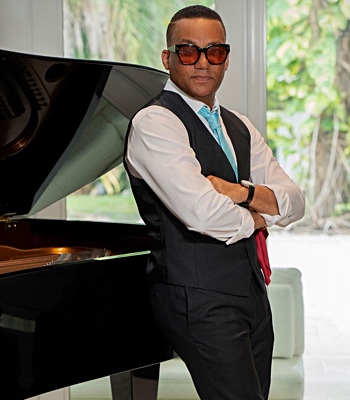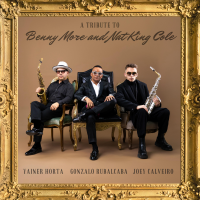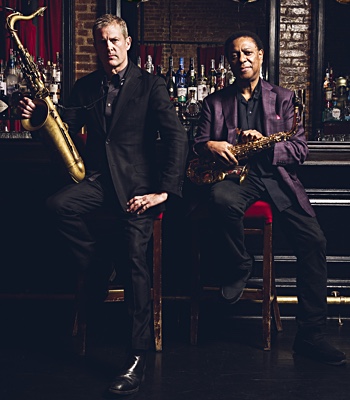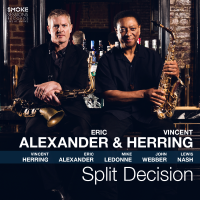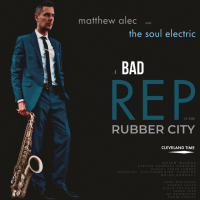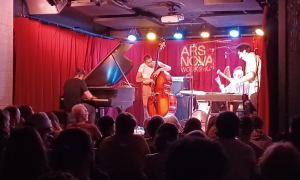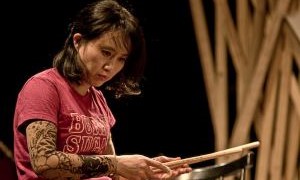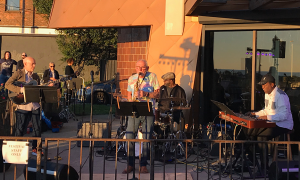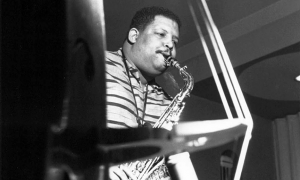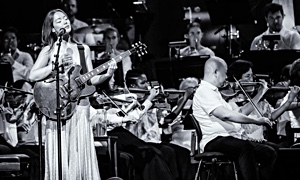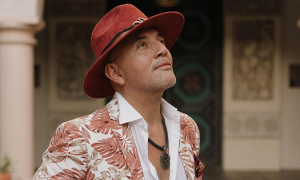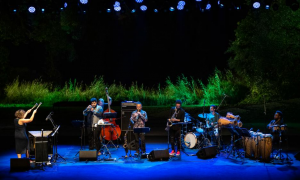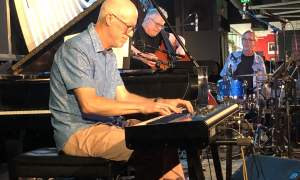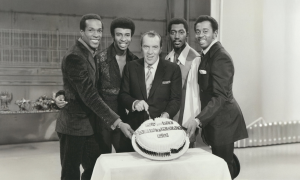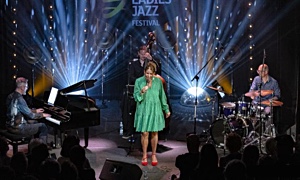Home » Jazz Articles » Live Review » International Festival Musique Actuelle Victoriaville, Day 4-5
International Festival Musique Actuelle Victoriaville, Day 4-5
The fourth day of the International Festival Musique Actuelle Victoriaville (FIMAV) was clearly the most anticipated, if attendance was anything to go by. With packed houses for shows including Anthony Braxton Sextet, Peter Brötzmann Chicago Tentet and William Parker's Little Huey Creative Music Orchestra, expectations were high.
Nobody was disappointed. Reed multi-instrumentalist and composer Braxton, who had already appeared at the festival this year in duet with guitarist Fred Frith, and as guest with noise improv band Wolf Eyes, was back to Victoriaville after a twelve-year absence, and it was clear that he was having a great time—both onstage and off. His earlier appearances this week were of the purely improvisational variety, and his duet with Frith represented the kind of innovation for which the festival is renowned—being the first time the two had played together. His sextet show was another significant marker, the North American premiere of a new extended composition, "345.
 A radical thinker in a class by himself, Braxton writes compositions that represent a complex view of the world. One look at his charts—which combine standard notation, passages of notes in specific colours and unique graphical representations—and it's clear that there's an advanced process in play. And watching the sextet perform, witnessing the kind of concentration and attention required by everyone with everyone, provided definite insight into how Braxton's revolutionary compositions make the transition from written page to performance. In addition to Braxton, the sextet included Taylor Ho Bynum on trumpet, Jay Rozen on tuba, Jessica Pavone on violin and viola, Chris Dahlgren on contrabass, and Aaron Siegel on drums and percussion.
A radical thinker in a class by himself, Braxton writes compositions that represent a complex view of the world. One look at his charts—which combine standard notation, passages of notes in specific colours and unique graphical representations—and it's clear that there's an advanced process in play. And watching the sextet perform, witnessing the kind of concentration and attention required by everyone with everyone, provided definite insight into how Braxton's revolutionary compositions make the transition from written page to performance. In addition to Braxton, the sextet included Taylor Ho Bynum on trumpet, Jay Rozen on tuba, Jessica Pavone on violin and viola, Chris Dahlgren on contrabass, and Aaron Siegel on drums and percussion.
Braxton's compositions aren't so much atonal as they are polychromatic, with different combinations of instruments playing abstruse lines at times in unison, other times contrapuntally, creating a seemingly infinite variety of colours and shaded gradations. Time can be rigidly defined or completely fluid, and improvisational passages can be open-ended, with direction coming from virtually everyone in the ensemble—in fact, smaller subsets within the ensemble are sometimes directed by more than one player simultaneously.
Bringing together a heady intellectualism and, at times, a kind of ordered chaos where collective improvisation was under a watchful eye that kept the forward momentum going, the seventy-minute performance blurred the line between richly structured, long-form contemporary classical composition and freer forms. Transitions between sections could be staggeringly rapid-fire, or they could be graceful, featuring drawn-out long tones with rich close harmonies. Solos built on layers developed by combinations in the ensemble—violin and arco bass here, trumpet, violin and tuned percussion there—were at times furiously abstract, elsewhere oddly melodic.
With a variety of extended techniques used by all to broaden the sonic palette, "345 was a stunning new piece of music that continues to assert Braxton as one of the great musical thinkers of the past forty years. His compositions demand nothing less than complete commitment by the audience, and it was clear that those in attendance were totally engaged. A remarkable piece performed by an outstanding ensemble and a clear festival high point.
Chinese guzheng player and singer Xu Fengxia demonstrated during her one-hour performance that it's possible to take an ethnic folk tradition and expand it into a looser, more exploratory context.
 The guzheng is a zither-like instrument with a broad tonal range, and Fengxia combined more traditional techniques with imaginative devices that included bowing the strings and hitting them with the palm of her hand. Tunable by repositioning a series of movable bridges, the instrument's evocative sound is the result of plucking the strings with one hand, while bending them behind the bridges with the other, giving the essentially pentatonically-tuned device a capacity for greater harmonic variation.
The guzheng is a zither-like instrument with a broad tonal range, and Fengxia combined more traditional techniques with imaginative devices that included bowing the strings and hitting them with the palm of her hand. Tunable by repositioning a series of movable bridges, the instrument's evocative sound is the result of plucking the strings with one hand, while bending them behind the bridges with the other, giving the essentially pentatonically-tuned device a capacity for greater harmonic variation.
While some of Fengxia's pieces were based on traditional Chinese and Mongolian songs, she also played an extended free improvisation that introduced all manner of microtonality and dissonance into a performance of deep beauty. Fengxia's voice, like the music, could be tender and whisper-like or sharp and piercing.
Fengxia demonstrated an intuitive sense of dramatic development that allowed each piece to unfold, gradually revealing its inner core. Often taking a few moments in unmoving silence at the end of a tune before acknowledging the audience's wild applause, Fengxia was clearly absorbed in the emotional resonance of each piece. Coaxing sounds like a lush harp at times, a deep bowed cello at others, Fengxia's command of the instrument was remarkable, from the simple lyricism of the meditative "Lotus to the more dramatic flourishes of a Chinese composition that told a Romeo and Juliet-like tale of forbidden love.
Like Tunisian oud player Anouar Brahem and British singer Robin Williamson, Xu Fengxia frees the guzheng from the constraints of its traditional background, challenging it to exist in a space of contemporary relevance and unfettered possibility.
German saxophonist Peter Brötzmann's Chicago Tentet, formed in '97, is something of a revolving door ensemble, with personnel changing from tour to tour. Still, with Brötzmann at the helm, there's a consistency of vision that takes directed free improvisation into an always-identifiable musical space, while reflecting the distinct personalities of the players involved. The current group, including reed multi-instrumentalists Ken Vandermark and Mats Gustafsson, trumpet players Joe McPhee and Magnus Broo, cellist Fred Lonberg-Holm, drummers Paal Nilssen-Love and Michael Zerang, tuba player Per-Ake Holmlander, and bassist Kent Kessler, may be Brötzmann's best tentet yet.
In an unusual move, the tentet eschewed any use of a PA system, instead relying on its almost frightening ability to acoustically fill a large concert hall. The strikingly innovative instrumental balance often shifted as the result of band members moving around to various parts of the stage in different configurations. And when everyone was in the pool, the band was loud, with a kind of raw energy, density and sheer power that could easily have them compete with the noise improv bands of the previous day.
While the ensemble opened with a kind of audacious free jazz fanfare, and would occasionally return to full out sonic blasts throughout the 75-minute set, the majority of the performance consisted of the tentet breaking down into smaller groupings. These reduced combinations created a potential for more immediate interplay and subtler textural landscapes, as opposed to situations where a greater number of players would emerge with denser colours.
Among the highlights of the set were Broo's vibrant and focused trumpet; Vandermark's extreme bass clarinet work and remarkable in-sync work with the drummers when he positioned himself at the back of the stage between Zerang and Nilssen-Love; Nilssen-Love and Zerang's tandem solo, which combined reckless abandon with an obvious simpatico; and, of course, Brötzmann himself—who can make the normally less-projectable soprano sax sound absolutely huge.
But it wasn't all about intensity and extremity. At times Brötzmann, McPhee and Gustafsson would develop close harmonies behind a soloist that created a sense of contained energy and delicate beauty. Conventional instrumental roles were discarded as small horn groupings would not only provide a harmonic center, but a rhythmic pulse as well, with Nilssen-Love and Zerang creating a rollicking wash of colour.
Spontaneity needn't imply lack of purpose, and the Brötzmann Tentet put on a performance that bridged the gap between weight and delicacy, density and the ethereal, power and subtlety. With a set that may have been free but had enough direction to give it form, Brötzmann demonstrated the multi-dimensional potential of bringing together a large group of players—many established leaders in their own right—who are as much about collective development as they are personal expression.
At William Parker's press conference earlier in the day, he talked about how music needs to transcend the barriers of narrow definition, and the performance of his Little Huey Creative Music Orchestra did just that. The fourteen-piece ensemble was at times a maelstrom of intersecting horn lines over a tumbling wash of rhythm, elsewhere swinging hard with Parker and drummer Andrew Barker providing a solid yet elastic foundation.
Like a concise musical history lesson, the sophistication of Parker's first composition provided the festival with the most overtly jazz-centric performance of its programme. Dedicated to the recently-departed bassist Percy Heath, who gave Parker the name "Iron Fingers, Parker's advanced conception integrated individual solos over multiple, often seemingly-conflicting layers of horns—three trumpets, three trombones, five reeds and tuba—and traversed a variety of straightforward and irregular meters throughout its fifty-minute length. The depth of the writing was revealed when, at their most apparently free, arrangements would appear to transition to the next soloist. At times the group sounded brash, but there were also periods where a small horn sections would emerge with rich, long tones providing contrast to the busier phrasing of the others. And while Barker was consistently fluid and Parker would alternate between steady patterns and more aggressive free play, there was always a pulse that provided forward motion, even as the composition felt in a constant state of flux.
Parker's second composition, "Gamma Cluster, was more subdued, a tone poem that contrasted with the more time-centric first piece. Unlike Brötzmann, who opted for breaking his tentet into smaller instrumental groupings, Parker seemed more intent on exploring the orchestral potential of the full ensemble.
In a nearly ninety-minute show, there were a number of standout performances, but alto saxophonist Rob Brown's extended solo in the first piece was a clear highlight, as were Darryl Foster's soprano spot and Steve Swell's brief opportunity in the set's closing piece. And while tuba player Dave Hofstra didn't receive a lot of specific attention, his contribution was absolutely vital, providing bottom-end harmonic movement in contrast to Parker's sometimes rhythmic, other times totally open-ended bass work.
A fine performance that illustrated yet another approach to mixing form with freedom, William Parker's Little Huey Creative Music Orchestra demonstrated the value of breaking down barriers and eliminating artificial labels in pursuit of a greater musical truth.
Another fine day at FIMAV, and another outstanding example of festival director Michel Levasseur's ability to programme in a way that gives each day its own complexion and musical emphasis.
Visit Xu Fengxia, Peter Brötzmann, , and the International Festival Musique Actuelle Victoriaville on the web. For a full schedule of this year's events, click here.
Continue: Day 5
Photo Credit
Martin Morisette
Tags
Comments
PREVIOUS / NEXT
Support All About Jazz
 All About Jazz has been a pillar of jazz since 1995, championing it as an art form and, more importantly, supporting the musicians who make it. Our enduring commitment has made "AAJ" one of the most culturally important websites of its kind, read by hundreds of thousands of fans, musicians and industry figures every month.
All About Jazz has been a pillar of jazz since 1995, championing it as an art form and, more importantly, supporting the musicians who make it. Our enduring commitment has made "AAJ" one of the most culturally important websites of its kind, read by hundreds of thousands of fans, musicians and industry figures every month.




